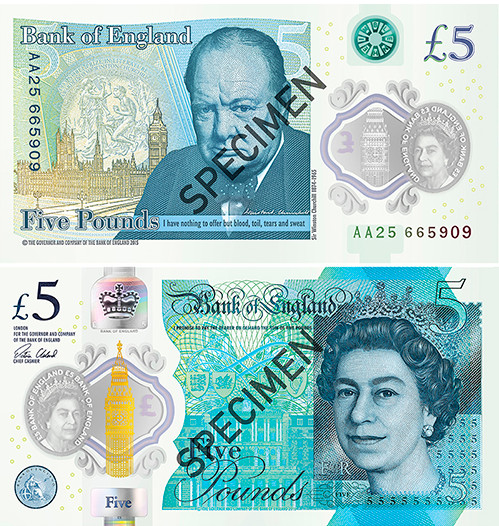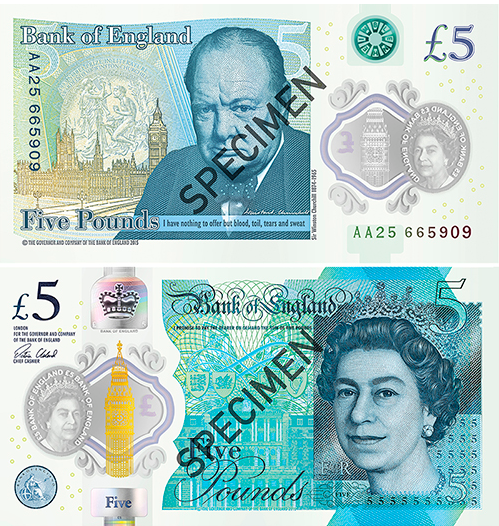
According to the Bank of England's manager Mark Carney, the new banknotes will be "cleaner, safer and stronger."
The first plastic banknotes are going into circulation on 13 September. The following year, the Bank of England is planning to issue a bill of 10 pounds with an image of writer Jane Austen, and by 2020 - 20 pounds with a portrait of painter William Turner.
The bank noted that the new notes are two and a half times more durable than their paper analogues.
Paper five pounds show social activist Elizabeth Fry, revered in the kingdom for its efforts to reform the prison system. The bills will cease to be lawful money in May 2017. After that, they will have to be exchanged at the Central Bank.
The whole world has long got used to plastic cards replacing cash. Some countries, however, went further, and partly switched to plastic banknotes. These bills are more durable than paper, but on the other hand, the plastic money has significantly lower level of protection, let alone the expensive production. Also, the plastic banknotes have a problem with a limited temperature range of use. On a hot day, they may stick together, and may break apart into two parts if folded when it’s freezing. Perhaps that is why there is not a single country where the paper bills entered into circulation.
Hygiene of polymer banknotes is among their other advantages: on such kind of money accumulates less bacteria. In addition, they are more difficult to break or crush, which simplifies work with vending machines. These notes are also more environmentally friendly since they are recyclable.
Banks and shops of the UK will have to pay a considerable sum to afford an opportunity to distribute plastic money - mainly because reconfiguration of ATMs and self-service machines require involvement of an engineer.
Some older models of ATMs will even be replaced. All these costs will fall on consumers’ shoulders, as stores will have to raise prices.
The world's first plastic banknotes were issued in 1988 by Bank of Australia (bills of $ 10), after which the country was followed by 26 more countries, including Hong Kong, New Zealand and Mexico.
It is said that since 1988, Australia has not registered a single case when a plastic fake bill passed the automatic validation, and the rate of false positives is also close to zero. It is unattainable performance for paper money.
source: bloomberg.com
The first plastic banknotes are going into circulation on 13 September. The following year, the Bank of England is planning to issue a bill of 10 pounds with an image of writer Jane Austen, and by 2020 - 20 pounds with a portrait of painter William Turner.
The bank noted that the new notes are two and a half times more durable than their paper analogues.
Paper five pounds show social activist Elizabeth Fry, revered in the kingdom for its efforts to reform the prison system. The bills will cease to be lawful money in May 2017. After that, they will have to be exchanged at the Central Bank.
The whole world has long got used to plastic cards replacing cash. Some countries, however, went further, and partly switched to plastic banknotes. These bills are more durable than paper, but on the other hand, the plastic money has significantly lower level of protection, let alone the expensive production. Also, the plastic banknotes have a problem with a limited temperature range of use. On a hot day, they may stick together, and may break apart into two parts if folded when it’s freezing. Perhaps that is why there is not a single country where the paper bills entered into circulation.
Hygiene of polymer banknotes is among their other advantages: on such kind of money accumulates less bacteria. In addition, they are more difficult to break or crush, which simplifies work with vending machines. These notes are also more environmentally friendly since they are recyclable.
Banks and shops of the UK will have to pay a considerable sum to afford an opportunity to distribute plastic money - mainly because reconfiguration of ATMs and self-service machines require involvement of an engineer.
Some older models of ATMs will even be replaced. All these costs will fall on consumers’ shoulders, as stores will have to raise prices.
The world's first plastic banknotes were issued in 1988 by Bank of Australia (bills of $ 10), after which the country was followed by 26 more countries, including Hong Kong, New Zealand and Mexico.
It is said that since 1988, Australia has not registered a single case when a plastic fake bill passed the automatic validation, and the rate of false positives is also close to zero. It is unattainable performance for paper money.
source: bloomberg.com





